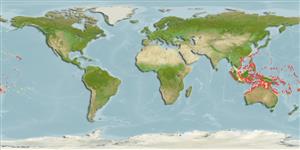Environment: milieu / climate zone / depth range / distribution range
Écologie
marin récifal; profondeur 0 - 45 m (Ref. 9710). Tropical; 30°N - 18°S, 97°E - 150°W
Indo-Pacific: Christmas Island in the eastern Indian Ocean to the Line Islands, north to the Ryukyu Islands, south to Rowley Shoals and the northern Great Barrier Reef; throughout Micronesia. Replaced by Chaetodon guttatissimus in the Indian Ocean (Ref. 37816).
Taille / Poids / Âge
Maturity: Lm ? range ? - ? cm
Max length : 12.0 cm TL mâle / non sexé; (Ref. 9710)
Épines dorsales (Total) : 13 - 14; Rayons mous dorsaux (Total) : 22 - 25; Épines anales: 3; Rayons mous anaux: 17 - 18. Overall color is brownish yellow with vertical rows of spots forming bands on the upper portions of the sides. A black-edged orange bar runs across the eye. The posterior edge of the caudal fin is transparent. Caudal peduncle is bright orange (Ref. 4855). Snout length 2.7-4.1 in HL. Body depth 1.6-1.8 in SL (Ref. 90102).
Common in coral rich areas and clear waters of lagoon and seaward reefs. Sometimes found on outer subtidal reef flats (Ref. 1602). Juveniles secretive (Ref. 48636). Feed on filamentous algae, corals, and benthic invertebrates. Often in pairs during breeding (Ref. 205), monogamous (Ref. 52884). Oviparous (Ref. 205). Occasionally hybridize with C. pelewensis in the southern part of its range (Ref. 9710). Minimum depth reported taken from Ref. 128797.
Life cycle and mating behavior
Maturities | Reproduction | Spawnings | Egg(s) | Fecundities | Larves
Distinct pairing (Ref. 205). Monogamous mating is observed as both obligate and social (Ref. 52884).
Randall, J.E., G.R. Allen and R.C. Steene, 1990. Fishes of the Great Barrier Reef and Coral Sea. University of Hawaii Press, Honolulu, Hawaii. 506 p. (Ref. 2334)
Statut dans la liste rouge de l'IUCN (Ref. 130435)
Menace pour l'homme
Harmless
Utilisations par l'homme
Pêcheries: intérêt commercial mineur; Aquarium: Commercial
Outils
Articles particuliers
Télécharger en XML
Sources Internet
Estimates based on models
Preferred temperature (Ref.
123201): 26 - 28.9, mean 27.8 °C (based on 344 cells).
Phylogenetic diversity index (Ref.
82804): PD
50 = 0.5000 [Uniqueness, from 0.5 = low to 2.0 = high].
Bayesian length-weight: a=0.02291 (0.01133 - 0.04632), b=3.00 (2.83 - 3.17), in cm total length, based on LWR estimates for this Genus-body shape (Ref.
93245).
Niveau trophique (Ref.
69278): 3.4 ±0.6 se; based on diet studies.
Résilience (Ref.
120179): Haut, temps minimum de doublement de population inférieur à 15 mois (Preliminary K or Fecundity.).
Fishing Vulnerability (Ref.
59153): Low vulnerability (10 of 100).
Nutrients (Ref.
124155): Calcium = 130 [66, 208] mg/100g; Iron = 0.967 [0.557, 1.662] mg/100g; Protein = 18.6 [17.4, 19.8] %; Omega3 = 0.129 [0.073, 0.224] g/100g; Selenium = 36.7 [18.9, 71.1] μg/100g; VitaminA = 49.2 [14.2, 174.1] μg/100g; Zinc = 1.65 [1.09, 2.43] mg/100g (wet weight);
